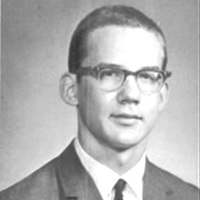Apollo 13 coverage starts tonight and goes on for the next two weeks! Don't miss a minute. Check local listings for broadcast times.

by John Boston
Johnny, We Hardly Knew Ye
The May Amazing presents a new face to the world. That is, the cover was actually painted for the magazine, as opposed to being recycled from the German Perry Rhodan. It’s not by one of the new artists editor White was talking up in the last issue, but rather by John Pederson, Jr., who has been doing covers on and off for the SF magazines since the late 1950s. Ditching the second-hand Europeans is a step forward in itself, though this particular cover is not much improvement: a slightly stylized picture of a guy sitting in a spacesuit on a flying chair with a disgruntled expression on his face, against an improbable astronomical background.

by John Pederson, Jr.
But it is an interesting development for a couple of reasons. First, in the letter column, White goes into more detail than previously about the European connection, in response to a question about why the covers are not attributed. White says: “The situation is this: an agency known as Three Lions has been marketing transparencies of covers from Italian and German sf magazines and has sold them to a variety of book and magazine publishers in this country, including ourselves. These transparencies were unsigned. One of our competitors credited its reprint covers to ‘Three Lions;’ we felt that was less than no credit at all. Therefore, unless the artist’s signature was visible, we omitted the contents-page credit. As of this issue, however, Amazing returns to the use of original cover paintings by known U.S. artists.”
So much, then, for Johnny Bruck, and a hat tip to the diligent investigators who have identified all his uncredited reprint covers as they were published. In addition to Pederson, White says, he’s obtained covers from Jeff Jones and Gray Morrow, and in fact a Jones cover is already on last month’s Fantastic. Further: “I might add that, beginning with our last issue, the art direction, typography and graphics for the covers of both magazines has been by yours truly.” So White has pried one more aspect of control of the magazine from the grip of Sol Cohen, presumably all to the good, though the visible effect to date is limited.
Continue reading [April 6, 1970] Uncovered (May 1970 Amazing)

![[April 6, 1970] Uncovered (May 1970 <i>Amazing</i>)](https://galacticjourney.org/wp-content/uploads/2025/04/amz-0570-cover-672x372.png)
